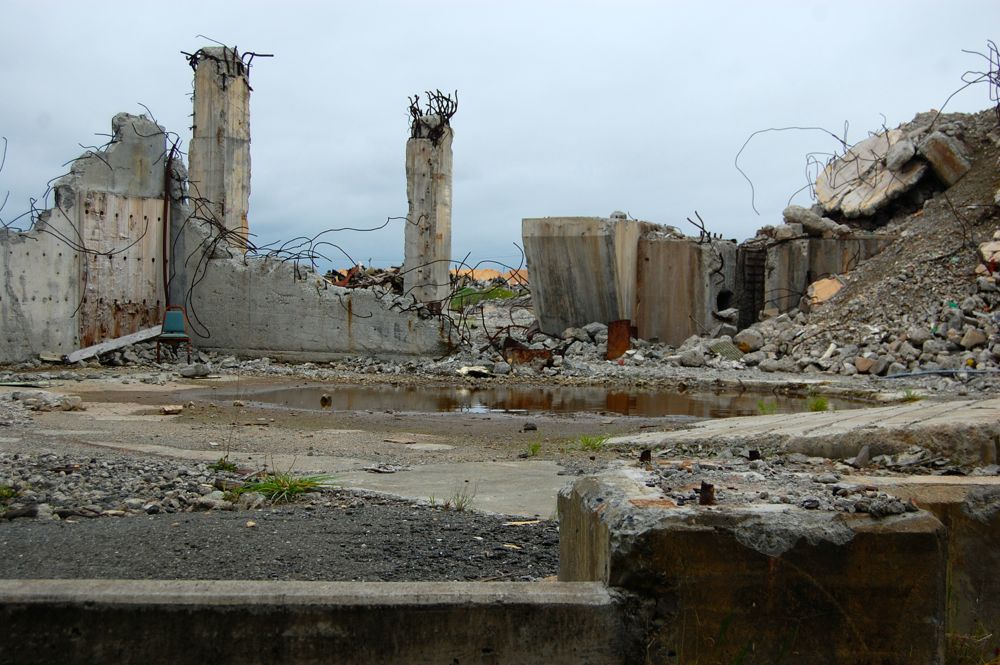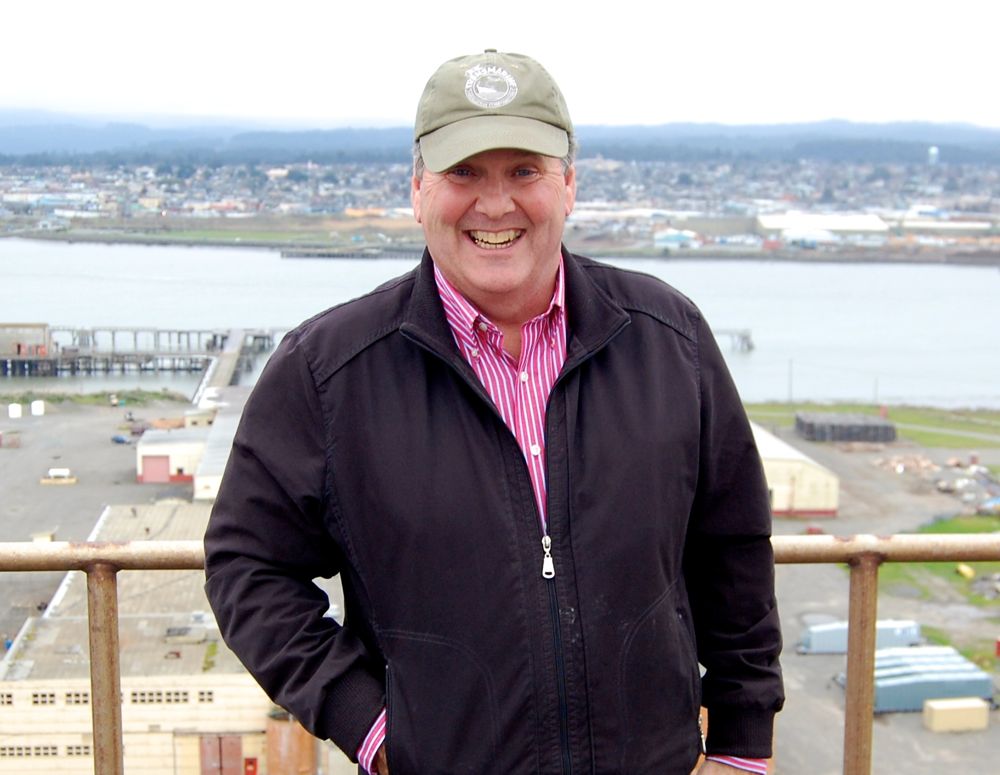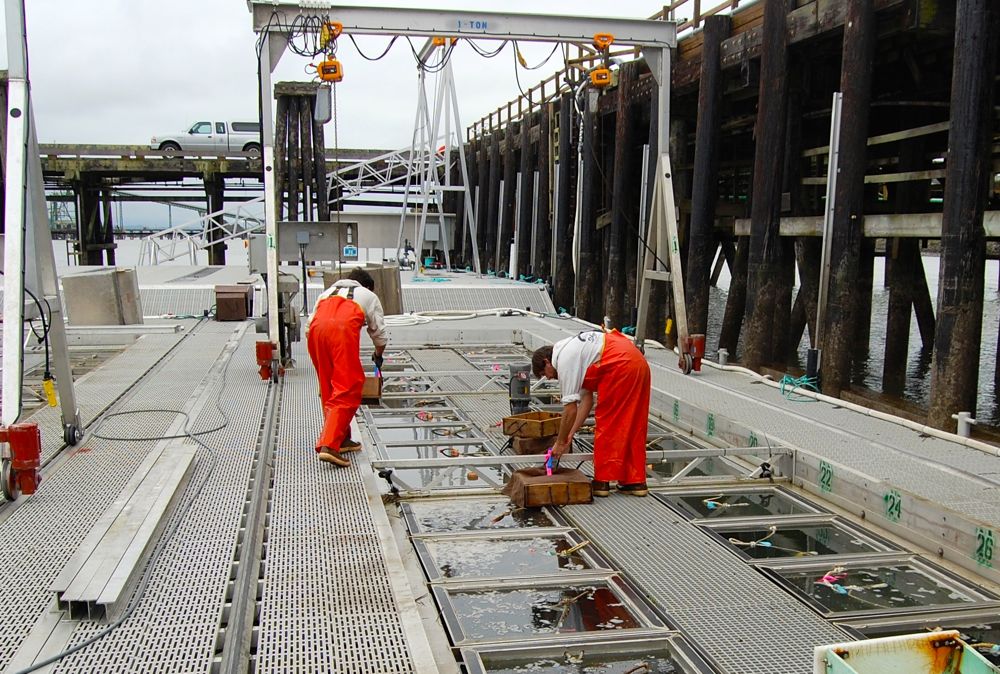 A sign from the pulp mill’s Louisiana-Pacific days lies in a pile of rubble with storage tanks in the background at the former pulp mill.
A sign from the pulp mill’s Louisiana-Pacific days lies in a pile of rubble with storage tanks in the background at the former pulp mill.
If you’ve been wondering what the defunct pulp mill out on the Samoa peninsula looks like these days, consider this: A group of students from Humboldt State University’s film department recently drove out there to shoot scenes (supervised, of course) of the zombie apocalypse. The property in its current state certainly fits the bill: Languishing buildings and rust-crusted storage tanks look as weathered and decrepit as the undead — on the outside, anyway.
Parts of the 72-acre site could also double for a war zone — think Sarajevo circa 1995: mountains of rubble and crumbling concrete walls sprouting wormy tangles of exposed rebar:
 Click any of these photos to enlarge them.
Click any of these photos to enlarge them.
The towering storage tanks — those that haven’t been demolished yet — are spray painted at their bases with the names of toxic chemicals and the caustic liquors used to break down wood chips into pulp.
Have a look: Below is an interactive 360-degree panorama of the mill recently captured from the roof of the 200-feet-high boiler building. You can pan up and down, left and right, zoom in and out. Look south to find the California Redwood chip facility and the DG Fairhaven Power plant. Across the bay to the east, of course, is Eureka. Squint and you can make out the State Route 255 bridge connecting the North Spit with Indian Island.
Oh, and that man trying to hide behind the ventilation pipe is Jack Crider, executive director of the Humboldt Bay Harbor, Recreation and Conservation District, who recently led the Outpost on a tour of the mill.
(Ignore the wonky railing; those are Google Camera glitches, not death traps.)
(If you have a laptop or tablet and want a bigger view of the “PhotoSphere,” click here.)
For decades this industrial site employed hundreds of union workers at a time. And while the smoke billowing from its 220-foot chimney smelled rank, it also served as a sign of productivity — as if the mill were the chugging steam engine pulling our region’s tree-powered locomotive.
But the timber industry is now a shell of its former self, and the pulp mill is a sort of shell, too, 250,000 square feet of mostly empty space.
It’s been more than a year and a half since the Humboldt Bay Harbor, Recreation and Conservation District, a public agency, took ownership of the 72-acre industrial complex with the idea of converting it into a “national marine research and innovation park.” And while the exterior may look a bit rough, the vacant industrial space is enticing for a variety of businesses.
Last weekend news broke that Yuba City-based US Mine Corporation has officially withdrawn its proposal to rent the site’s Redwood Terminal building to process ore into gold. In a letter to Harbor District Jack Crider, the company’s president and CEO said, “we could not accept the risk involved with the significant effort and substantial cost it would have taken to receive agency and public approval.”
But Crider, a jolly man who previously served as executive director of two Oregon ports — Tillamook Bay and Astoria — says there’s no shortage of other businesses interested in moving in and taking advantage of the site’s assets, which include a 30 million-gallons-per-day water clarification system, a mile and a half of ocean outfall line, deep water access and lots of warehouse space.
 Humboldt Bay Harbor, Recreation and Conservation District Director Jack Crider.
Humboldt Bay Harbor, Recreation and Conservation District Director Jack Crider.
On a recent overcast afternoon, Crider gave the Outpost a tour of the facility, from the crumbling wreckage of demolished storage tanks, whose caustic contents were recently removed and exported under supervision from the Environmental Protection Agency, to the panoramic view from atop the boiler building.
Down on ground-level, one wall of a corrugated metal storage building has peeled open like a giant sardine can, and as Crider walked past, its sheet metal tongues thundered and whined in the ocean breeze.
Crider didn’t seem to notice the ghostly sounds as he walked cheerfully through the blighted property. Instead he sounded almost like a kid in a candy store full of empty shelves awaiting a big shipment of Skittles, Snickers and Milk Duds. The sweets, in this analogy, will be rent-paying businesses.
“All I know is I need tenants, and I need ‘em now,” Crider said.
One has already moved in. Taylor Mariculture, a subsidiary of Washington-based Taylor Shellfish, grows clam and oyster seeds. The company started the permitting process several years ago and has already installed a series of floating upwell systems, called FLUPSYs, on the site’s dock.
 Taylor Mariculture employees work with baby oysters in FLUPSYs, or floating upwell systems, on the dock by the pulp mill.
Taylor Mariculture employees work with baby oysters in FLUPSYs, or floating upwell systems, on the dock by the pulp mill.
In one corner of the giant warehouse, Taylor employees were busy constructing a hatchery, or larvae-setting facility, where shallow tanks of seawater will be heated to about 75 degrees, allowing oyster larvae to feed on microalgae and develop into spats (baby oysters). From there the spats will be moved to the FLUPSY nursery out on the dock.
Coast Seafoods, the largest oyster farmer on Humboldt Bay, is right behind Taylor, working through the permit process in hopes of renting 10,000 square feet of warehouse space, Crider said.
Oyster farming on Humboldt Bay is already a $12 million annual industry, and with Taylor Mariculture, Coast Seafoods and Hog Island each investing $2 million to $3 million to expand hatchery production and seed-setting operations, Crider said, “I think we’ll boost this up to a $50 million-a-year industry. … We’ve got something pretty phenomenal that’s going on here right now.”
The Audubon Society recently launched a campaign against Coast Seafood’s planned expansion, arguing that the project threatens to destroy eelgrass and bird habitats. Crider said the Harbor District will undertake a full Environmental Impact Report before moving forward with the project.
Meanwhile, the pulp mill is garnering attention.
“Yeah, lots of interest,” Crider said. “That’s the encouraging part about this whole thing, is that we’ve had a ton of inquiries. Lots of tire kickers. We’ve given a lot of tours.”
Among the potential tenants: At least two companies are looking into building a wood pellet mill; Four Seasons Lumber is pursuing a wood chip export facility; Sustainable World Solutions has obtained an exclusive right to negotiate for the water treatment plant; local aquaponics businesses are sniffing around; Northcoast Horticulture Supply is interested in warehouse space; and Garberville-based cannabis growers Wonderland Nursery have toured the site.
“We understand that these mills have great value for repurposing,” said Kevin Jodrey, Wonderland’s cultivation director. Years ago, Jodrey and his former business partners spent close to $400,000 toward setting up a medical marijuana facility in Arcata’s old Britt Lumber Mill before U.S. Attorneys Office henchmen intimidated the City of Arcata into putting the kibosh on the project.
Jodrey said things are still in the “maybe” stage for Wonderland Nursery, but he and his colleagues were happy to tour the facility recently. “Because I had experience doing a mill already, I knew the value of the infrastructure was priceless,” Jodrey said. “They don’t build these things anymore.”
Not the least of the site’s assets is its access to copious amounts of water — in the neighborhood of 60 million gallons per day. Back when there were two pulp mills on the peninsula they combined to use 40 to 50 million gallons daily. The Humboldt Bay Municipal Water District is still looking for industrial customers who can restore that demand so it doesn’t lose rights to that volume of water.
Marijuana nurseries, of course, use lots of water. But would they be permitted at the pulp mill? Or any of those other proposals, for that matter — pellet mills? Wood chip exports?
That remains an unanswered question. The county’s stance is that, per current zoning, the only thing principally permitted on the site would be a paper mill. The pulp mill was only allowed because it was grandfathered in, according to Crider.
Wonderland Nursery hired former Humboldt County Supervisor Bonnie Neely, now a senior policy advisor with national law firm Nossaman LLP, to explore the permitting issues involved in setting up a nursery at the former pulp mill. Neely was also retained by the Harbor District to investigate what’s allowed at the industrial site under the current Local Coastal Plan.
The ultimate authority on these matters, Crider said, will be the California Coastal Commission.
 The control room, like much of the pulp mill’s interior, looks a bit dated.
The control room, like much of the pulp mill’s interior, looks a bit dated.
Continuing the tour, Crider led the way through a circuitous warren of offices — hallway after hallway lined with dark, musty rooms. The mill was built in 1964, and aside from the electronics it doesn’t look like much has been replaced in the intervening years. Even the General Electric generator powering the place is vintage — and still valuable.
“In the [mill] industry … this was the most reliable generator that GE ever made,” Crider said proudly. The following Monday he showed the generator and other pulp mill assets to representatives of KapStone Paper and Packaging, the same company that agreed to accept the pulp mill’s caustic pulping liquors for use at its Washington pulp mill. Crider is hoping the company will buy the generator, the mill’s control system and other components.
“I’d be happy with about $300,000 out of this,” Crider said, gesturing at the generator. “Happy with about $180,000 out of the control system. Hopefully the other components I get another $130,000.”
 The best generator GE ever made?
The best generator GE ever made?
KapStone sent people back for a second look this week, which Crider considered a good sign. The boiler building, meanwhile, has 4,000 tons of scrap metal that the Harbor District has been trying to sell to a Philippines company. “The goal,” Crider said, “is for us to make enough to repay Coast Seafood for the money we borrowed to truck the liquors out.” The Harbor District last year secured a $1.25 million loan from the company for that purpose.
The agency’s overall financial picture is mixed. On the one hand, operating revenues during the 2013-2014 fiscal year increased by $245,555, a 20 percent jump over the previous year. Grants and other income also increased by more than 20 percent. On the other hand, liabilities jumped, too, including nearly $1.2 million in environmental remediation costs. By year’s end the district had lost $280,640, which is roughly average since 2000-2001.
Have a look at the full financial report here.
Crider walked into one nondescript office — just as musty as the rest — and said this is where EPA officials set up shop when they’re on scene. The federal agency is due to return this month and remain on-site until August or September, he said, overseeing the remainder of the cleanup operation. Of the $6 million total price tag for that task, the Harbor District only has to pony up $400,000. This figure was the result of the EPA’s repayment criteria, which apply different calculations based on a government agency’s financial status, the demographics of the community and other factors.
Walking through an outdoor section of the property, Crider pauses to look around. He’s hoping the EPA workers will take away all the piles of debris lying around, he said. And the director of the cleanup project mentioned that he’d like to tear down the giant smokestack, that productivity symbol of yesteryear. Crider walked toward the section of property that resembles an urban war zone.
“This was probably one of the worst, if not the worst, areas right here,” he said. This was a tank farm holding thousands of gallons of caustic fluids, including more than 15,000 gallons of sulfuric acid. Crider walks close to a circular rust-stained pedestal — the concrete base of an acid tank that has since been removed. “This tank was leaking,” he said, pointing down at two pebbly, crumbling streaks. “You can see how it was just etching, eating the concrete up right there.”
Eventually, Crider tracked down the keys to the boiler building and we walked inside. The massive tank towers skyward, surrounded by a network of industrial steel crossbeams painted teal, thick, cross-hatching pipes and steering wheel-sized valve handles. If someone were to make a Super Mario Brothers movie with an aesthetic of gritty realism, they might want to film here.


Crider started climbing the metal stairs, which have slots you can see through, and as you ascend higher and higher the view down can start swimming, causing your guts to lurch with momentary vertigo.
“I always try to verify it,” Crider said, breathing a bit heavy from the climb, “but this is supposed to be the tallest building between Portland and San Francisco.” By the time we’d reached the 17th floor we were both panting a bit. Crider unlatched a hatch in the ceiling and led the way up a few metal rungs and onto the roof. The brisk wind caused this reporter’s eyes to water, momentarily obscuring what must be the most sweeping panoramic view in Humboldt County.
Crider peered over the south railing and then the east railing, pointing out the various landmarks, identifying each of the property’s buildings and grinning from ear to ear.
One more perspective:

CLICK TO MANAGE